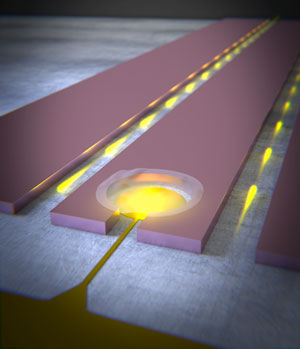| Posted: Aug 25, 2014 |
Graphene drum could form future quantum memory (w/video)
|
|
(Nanowerk News) Scientists from TU Delft’s Kavli Institute of Nanoscience have demonstrated that they can detect extremely small changes in position and forces on very small drums of graphene. Graphene drums have great potential to be used as sensors in devices such as mobile phones. Using their unique mechanical properties, these drums could also act as memory chips in a quantum computer. The researchers present their findings in an article in the August 24th edition of Nature Nanotechnology ("Optomechanical coupling between a multilayer graphene mechanical resonator and a superconducting microwave cavity"). The research was funded by the FOM Foundation, the EU Marie-Curie program, and NWO.
|
 |
| Using a 2D crystal membrane as a mirror in an ‘optomechanical cavity’. (Image: TU Delft)
|
|
Graphene drums
|
|
Graphene is famous for its special electrical properties, but research on the one-layer thin graphite was recently expanded to explore graphene as a mechanical object. Thanks to their extreme low mass, tiny sheets of graphene can be used the same was as the drumhead of a musician. In the experiment, scientists use microwave-frequency light to ‘play’ the graphene drums, to listen to its ‘nano sound’, and to explore the way graphene in these drums moves.
|
|
Optomechanics
|
|
Dr. Vibhor Singh and his colleagues did this by using a 2D crystal membrane as a mirror in an ‘optomechanical cavity’. “In optomechanics you use the interference pattern of light to detect tiny changes in the position of an object. In this experiment, we shot microwave photons at a tiny graphene drum. The drum acts as a mirror: by looking at the interference of the microwave photons bouncing off of the drum, we are able to sense minute changes in the position of the graphene sheet of only 17 femtometers, nearly 1/10000th of the diameter of an atom.”, Singh explains.
|
|
Amplifier
|
|
The microwave ‘light’ in the experiment is not only good for detecting the position of the drum, but can also push on the drum with a force. This force from light is extremely small, but the small mass of the graphene sheet and the tiny displacements they can detect mean that the scientist can use these forces to ‘beat the drum’: the scientists can shake the graphene drum with the momentum of light. Using this radiation pressure, they made an amplifier in which microwave signals, such as those in your mobile phone, are amplified by the mechanical motion of the drum.
|
|
|
|
Memory
|
|
The scientists also show you can use these drums as ‘memory chips’ for microwave photons, converting photons into mechanical vibrations and storing them for up to 10 milliseconds. Although that is not long by human standards, it is a long time for a computer chip.
|
|
“One of the long-term goals of the project is explore 2D crystal drums to study quantum motion. If you hit a classical drum with a stick, the drumhead will start oscillating, shaking up and down. With a quantum drum, however, you can not only make the drumhead move up and then down, but also make it into a ‘quantum superposition’, in which the drum head is both moving up and moving down at the same time ”, says research group leader Dr. Gary Steele. “This ‘strange’ quantum motion is not only of scientific relevance, but also could have very practical applications in a quantum computer as a quantum ‘memory chip’”.
|
|
In a quantum computer, the fact that quantum ‘bits’ that can be both in the state 0 and 1 at the same time allow it to potentially perform computations much faster than a classical computer like those used today. Quantum graphene drums that are ‘shaking up and down at the same time’ could be used to store quantum information in the same way as RAM chips in your computer, allowing you to store your quantum computation result and retrieve it at a later time by listening to its quantum sound.
|

